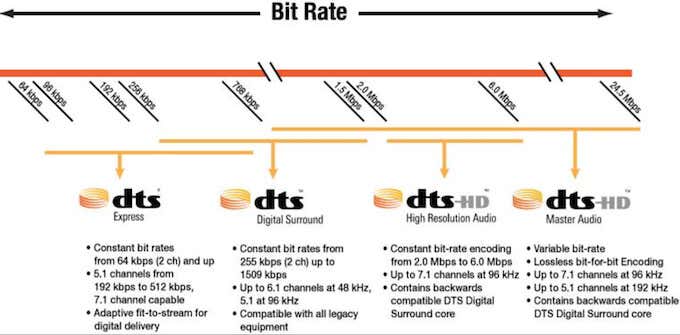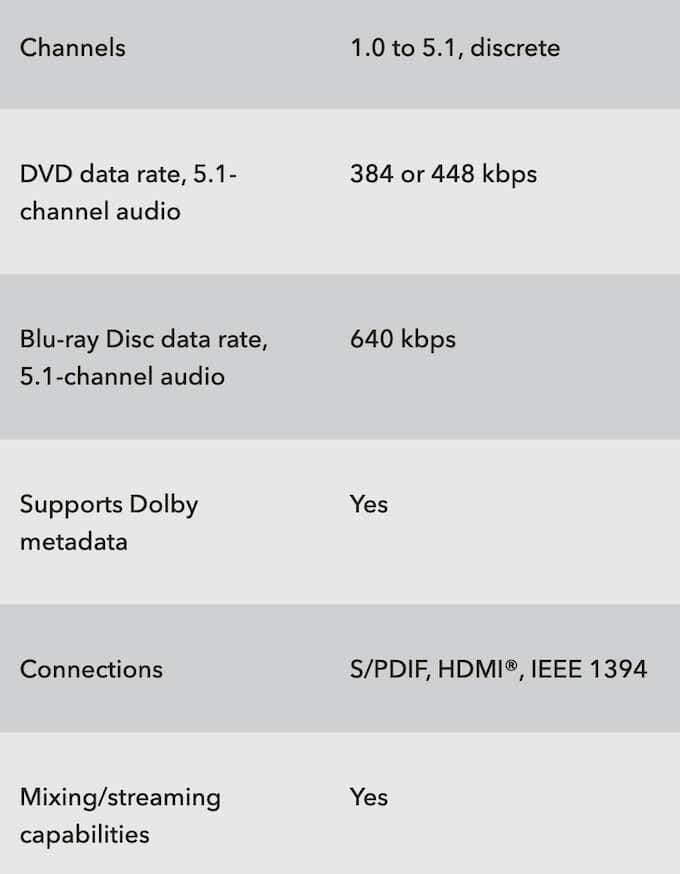The most popular surround sound formats are DTS and Dolby Digital. Both audio compression technologies allow moviemakers to record quality surround sound that can be reproduced at home by your audio system, but which one does it better? Learn the difference between DTS and Dolby Digital and see which one delivers the most spine-tingling and immersive sound.
What’s Dolby Digital?
Dolby Digital is a multi-channel audio format created by Dolby Labs. Even if you’ve never heard of DTS, you’ve probably heard of Dolby Digital before. When it comes to surround sound, Dolby Digital is considered the industry standard. That doesn’t have anything to do with its superiority. Dolby Labs has simply been around longer than DTS. Dolby Digital made its debut in Batman Returns in 1992. Since then, Dolby has introduced several advanced audio codecs, including Dolby TrueHD and Dolby Atmos. TrueHD is a lossless format that promises to deliver sound identical to the movie studio’s master recording. Atmos is a next-generation audio system which according to Dolby, is “the most significant development in cinema audio since surround sound.”
What’s DTS?
DTS (originally Digital Theater Systems) first appeared back in 1993. Straight away, they began competing with Dolby Digital for the superior surround sound format title. The first movie to use DTS was Steven Spielberg’s Jurassic Park, which launched DTS’ popularity. Since then, the company started producing consumer hardware and released many more advanced surround sound formats. This included a lossless format known as DTS-HD Master Audio and DTS:X — a rival for Dolby’s Atmos. Generally, DTS isn’t as widely known (or available for that matter) as Dolby Digital. However, some users believe that it’s a superior format as it encodes audio at higher bit rates.
DTS vs. Dolby Digital: The Similarities
Most high-end audio systems available for setting up at home support both Dolby Digital and DTS. In their basic form, both Dolby Digital and DTS offer surround sound codecs for 5.1 setups — a typical home cinema system with five speakers and one subwoofer. More advanced versions of the formats support 7.1 – channels, overhead speakers, and HD surround sound. Today, both standards are equally used by studios to compress dense files with multi-channel audio and save space on disc (for DVD or Blu-Ray) or streaming bandwidth (for services like Netflix). Both Dolby and DTS have “lossy” and “lossless” codecs. The audio of the lossy version will differ to some degree from the source, while lossless formats promise to deliver studio-level audio performance, but with some compression. Dolby and DTS use extra technologies like enhanced surround sound for better immersion, specific encoders for stereo sound, and object-based sound effects for added realism. Other than your home cinema, you can find both DTS and Dolby Digital on your computer, smartphone, Blu-Ray player, or gaming console.
DTS vs. Dolby Digital: The Differences
Each of the standards comes with different quality options (or tiers) for different forms of media. Here are the different options for each:
DTS
DTS Digital Surround: 5.1 max channel sound at 1.5 megabits per second (widely used on DVDs)DTS-HD High Resolution: 7.1 max channel sound at 6 megabits per second (supported by services like Netflix)DTS-HD Master Audio: 7.1 max channel sound at 24.5 megabits per second (“lossless” quality available on Blu-Ray discs)DTS:X
Dolby Digital
Dolby Digital: 5.1 max channel sound at 640 kilobits per second Dolby Digital Plus: 7.1 max channel sound at 1.7 megabits per secondDolby TrueHD: 7.1 max channel sound at 18 megabits per second (“lossless”)Dolby Atmos
While both standards are relatively close in audio performance, there are certainly some technical differences that separate them. The main difference between DTS and Dolby Digital is in the bitrates and compression levels.
DTS:
DTS Surround compresses 5.1 digital audio data applying a maximum bit rate of up to 1.5 megabits per second. On DVD, the bitrate is limited to around 768 kilobits per second. DTS requires compression of about 4:1 (due to the higher bitrate supported by the format).
Dolby Digital:
Dolby Digital applies a bitrate of 640 kilobits per second on Blu-Ray discs.On DVD, the bitrate is limited to 448 kbps. Dolby Digital has to use compression of around 10:1 to squeeze in the same amount of data as DTS.
In theory, the lesser the compression used in the encoding, the more realistic sound you get. DTS seems to have a clear advantage over Dolby Digital due to the higher bitrate in all of its versions on specs alone. But that’s not enough to determine which of the two standards offers a more realistic sound experience. You have to consider other factors like the signal-to-noise ratio, speaker calibration, or dynamic range.
Which One is Superior: DTS or Dolby Digital?
While DTS might seem superior on paper, the difference between DTS and Dolby Digital is subjective and depends a lot on a specific user and their sound system setup. If you haven’t invested a lot of money in your sound system, you might not notice any difference. In that case, you’ll be fine with whichever one you chose for your home theater setup. But if you’re an audiophile planning to spend some serious money on a top-performance receiver and speakers, then it’s best to test both and make a final decision based on your preferences. DTS or Dolby Digital? What’s your personal favorite and why? Share your experience with these surround sound formats in the comments section below.





